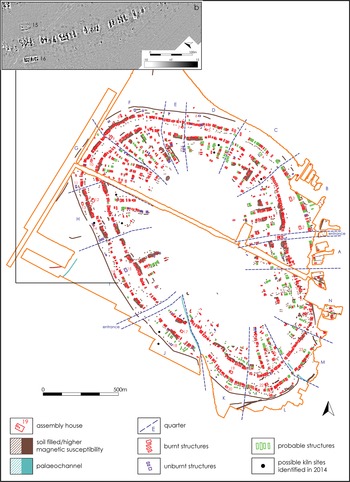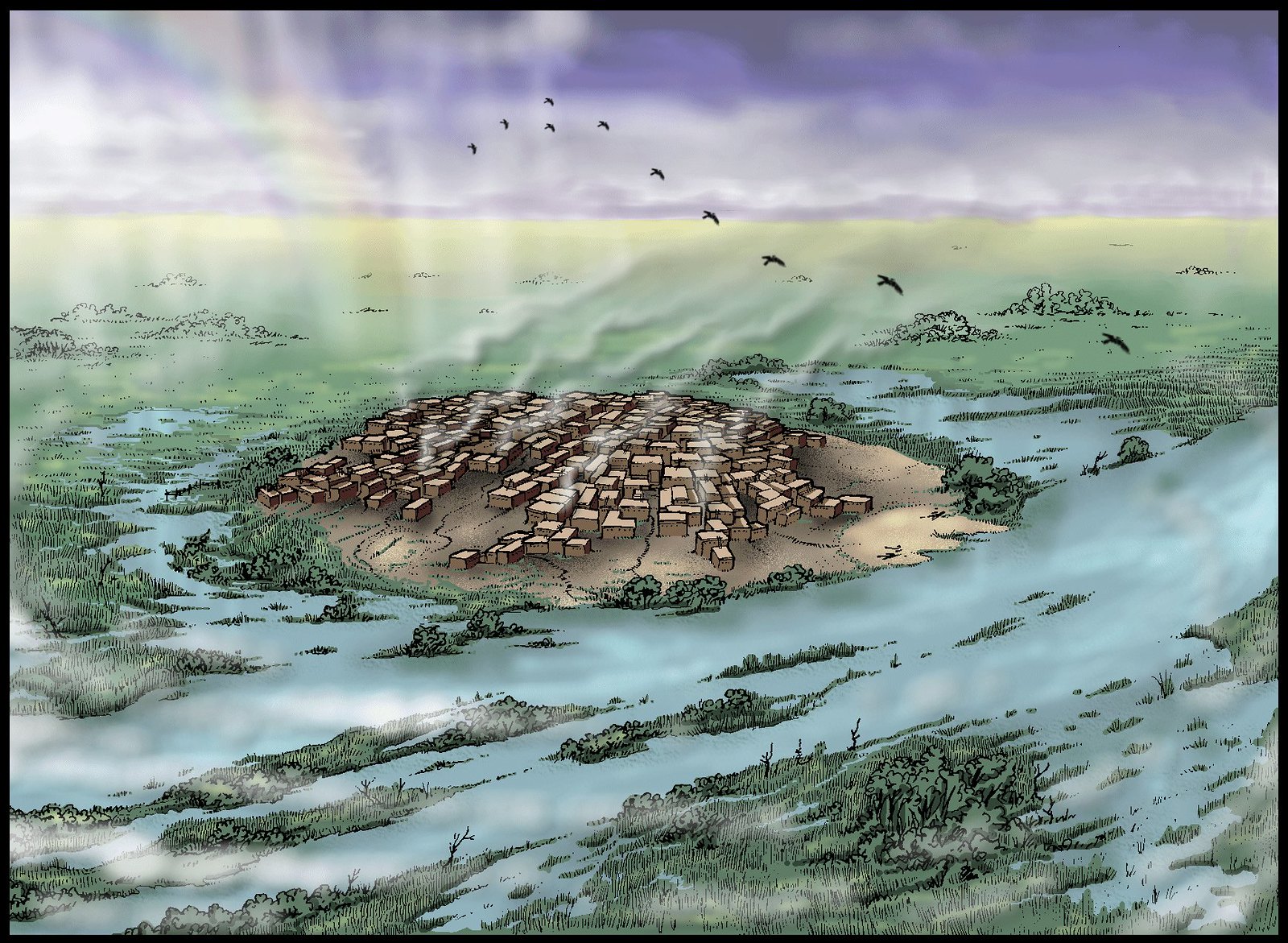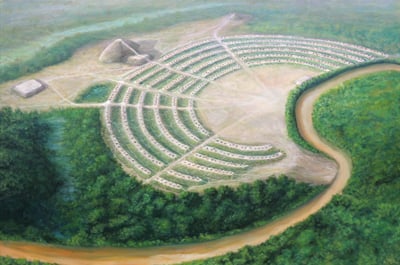Many modern cities are focal points for escalating oppression. Since European colonisation, an idea that humans march one-way from simple egalitarian bands towards contemporary complexity has dominated. Cities are a rite of passage on this supposed metamorphosis. The story goes: civilisation is a package, with arts and culture comes hierarchy, large societies need top-down governance. This gives a false choice: suck it up or return to caves.
The Dawn of Everything, published in October 2021 by David Graeber and David Wengrow is 700 amazing pages breaking down self-fulfilling myths about humanity since the Ice Age. The book offers a great deal for contemporary municipalism, not least as the first cities were largely collaboratively built. Structures of domination did arise, but often much later than when cities arose. Contrasting ancient examples with contemporary democratic projects creates a bridge on which we can get over notions that cities are inevitably hierarchical. Surveying cities back to the beginning also offers a vantage point to better understand municipalism.
Autonomous communities of scale
A central tenet in our supposed linear history is: larger societies means more domination. The Zapatistas (EZLN) of Chiapas and the Autonomous Administration of North and East Syria (AANES), aka Rojava, are exemplars discrediting this.
Since 1994, an estimated 300,000 people in southern Mexico (2018 figures, growing since) have created an autonomous democratic system where they run their lives from healthcare to education through local democracy. Whilst in north and east Syria since 2012, a local democratic system based on local councils – called democratic confederalism – transformed life based on women’s liberation, welcoming refugees, ethnic cohesion and inclusive democracy for 4.6 million people in 2014 (with population decreasing since).
The book showcases evidence of varied complex societies, egalitarian or without full-time elites. The free movement of people and ideas is clear from similar tool use from the Alps to Mongolia during the late Upper Paleolithic (25,000-12,000 BCE). Back then, hunter-gatherers frequently amassed seasonally reaping nut harvests, intercepting migratory animals or fish runs. For instance, Mammoth Houses (circa 23,000 BCE) discovered in today’s Russia had amber, marine shells and animal pelts from long distances. Similarly at Stonehenge, (circa 3000 BCE) today’s UK, and Poverty Point, (circa 1600 BCE), today’s US, seasonal visitors amassed, leaving resources from much further afield.
More recent societies have also practised a seasonal to-and-fro, often with two political systems. For the Arctic Inuit relationships get more egalitarian when they unite, more patriarchal and hierachical the rest of the year. For the Nambikwara, of the Amazon, it is the opposite way around.
The Dawn of Everything showcases how humanity’s story is complex and diverse, with much experimenting. The contemporary world stuck in one system of domination seems the exception. At the daybreak of cities, too, elites were mainly missing.
Tell Sabi Abyad (circa 6200 BCE) was a village in today’s Syria, part of a network of similar villages called the Ubaid. It had about 150 inhabitants, who used tokens to ensure everyone received the same amount of specific things. The Ubaid network connected small sites across Mesopotamia for a millennium, interconnected with the principle of equal access to resources, which laid the foundations for some early Mesopotamian cities.
Egalitarianism appears very different in non-urban societies. The Hopewell Interaction Sphere was a gathering spot for Americans from across southeast Turtle Island (100 BCE-500 CE), where they built massive and intricate earthworks. Like the Ubaid network, we see little signs of centralised power or permanent elites. Yet in difference, Graeber and Wengrow explain egalitarianism in the Ubaid is about “suppression of individual differences between people and households” whereas “the unity of Hopewell lay in the celebration of difference.”
Pathways to other cities
History’s conformist narrative tells non-European and non-modern people are child-like. The bedrock of structural racism is judging others as not matching the self-proclaimed progress of white Europeans. This narrative serves the Eurocentric establishment another way too: it discounts the smorgasbord of political possibilities occurring throughout history.
As a way of doing politics that is inherently decentralised and about sharing power, municipalism is both anti-colonial and it offers remedy to this political nihilism.
Different types of municipalism have been characterised as “platform, autonomist and managed” by geographer and municipalist writer Matthew Thompson. Platform municipalism is a movement of social movements combining to run the city, as they have done in Barcelona. Municipalism can also focus on building autonomous systems beyond existing ones: Cooperation Jackson (US) is building a solidarity economy anchored in local cooperatives and popular assemblies. In managed municipalism, local government leads an economic transformation, for instance by using local procurement to support local cooperatives, as is happening in Preston (UK).
Drawing on ongoing work – including with the European Municipalist Network mapping project – I would identify two more pathways that are gaining ground: civic list municipalism and social municipalism. The first is when NGOs, small political parties and urban activists can create civic list to take back the city, as they have done across France or Zagreb; what differentiates this from platform municipalism is less influence on social movements. Also social movements are combining to build pressure on local government – looking through a municipalist lens but without running for elections, as is happening with a particular focus on housing in Berlin and Capetown. Overall there is a great differentiation across these five pathways, and debate, but also overlaps and dual strategies. This echoes how cities were co-created in a variety of manners in the past.

Ancient cities: ancient rights
Early cities were “a conscious experimentation in urban form” and “surprisingly few contain… signs of authoritarian rule,” Graeber and Wengrow write. They substantiate this by the absence of palaces, prisons, centralised stores, administration, fortifications, and other landmark remains that appear clearly in later cities. Applying a contemporary idea, early urban dwellers can be said to have had a strong ‘Right to the City’, meaning they collaboratively shaped their lives and municipalities.
We can see this in the ‘world’s oldest town’ Çatalhöyük, in today’s Turkey, lasting between 7400-5900 BCE. Its townsfolk – around 5,000 – all lived in equal sized attached homes. Without streets, people climbed over the roofs, entering homes via ladders.
What Çatalhöyükans thought is unknowable, but we can probe our ideas on municipal living. Roofs aside, there was little common space to arrange collectively. Instead, these urbanites had an equal opportunity to envision the city inside out. Archaeological records show egalitarian households, with equitable access to food and little division by class or gender. Inside houses differed greatly, in terms of rituals, layout and creative outputs.
Taljanky – today’s Ukraine – and concurrent sites also defy the orthodox view of old cities, as they too lack evidence of centralised power. Taljanky was one-thousand or so equally sized and strongly built homes set in a circle. The central area was perhaps used for popular assemblies, penning animals, rituals or all three. Nearby there were many similar ring shaped municipalities (4100-3300 BCE) totalling an estimated 100,000 people, each place interdependent, a few hours walk apart.
Modern conurbations, in contrast, often have central areas and ones of privilege lording it over impoverished districts. But municipalism provides pathways to break this centralisation. Take Zagreb. In May 2021, the citizen platform Možemo (We Can) won against a corrupt mayor in power for decades. They won this on a 28-point manifesto, co-created by around 10,000 Zagrebians, which included creating a ‘polycentric city’ that stops only prioritising downtown.
Another aim of Zagreb – and many municipalist projects – is to deal with today’s ecological meltdown. Again ancient Ukraine shows there is nothing innate about cities and overconsumption. Graeber and Wengrow suggest Taljanky’s ecological footprint was minimal, likely including a conscious effort “to avoid large-scale deforestation.” These places had a very diverse economy, small scale gardens, hunting and gathering, keeping animals, orchards and trade to distant places. This lasted centuries without warfare or elites.
The normative view today means critics can write off projects for ecological well-being as naïve, juvenile. Yet increasingly local governments are becoming a battle-ground to take climate action, against national governments co-opted by corporations. The red-green municipalist leaning city of Amsterdam is leading a charge of cities reimagining circular economics, utilising enough resources for everyone to thrive, whilst rejecting endless growth that the planet cannot handle. Whilst there are challenges to put common sense into action, it seems more than symbolic that this new way of thinking is called “Doughnut Economics”, the shape of the world’s ‘first town’.

Decolonisation and depatriarchicalisation
The process that a way of life spreads – say Ukraine conurbations or Ubaid villages – is called colonisation by social scientists. Even if it was spread without violence, likely consensually. Graeber and Wengrow point out we need new words to redefine our thinking. Here contaminationism – an idea from the alter-globalisation movement that Graeber has discussed elsewhere, is useful for looking back and forward.
Contaminationism is the notion that participative practises are contagious. So for instance, during the alter-globalisation movement (inspired by the Zapatistas), people working through consensus and assemblies snowballed after more saw this in action. Then more people saw and adopted these ways of politics, later including during the Squares movement of 2011, which in turn influenced those, across Spain, taking back their cities in 2015.
This contaminationism offers a way to imagine how all the Ubaid or Ukrainian people consensually started doing the same thing without violence. Something similar happened in Sumeran city Uruk. Smaller places replicated the city, which had a temple that produced new goods and guaranteed quality and purity. Uruk is also the first known city with writing. It also began with a participative democracy that happened in a Great Court, a sunken and shady plaza.
Eurocentric history’s one-track mind is exemplified as it asserts Ancient Athens is democracy’s birthplace. Surely people have been doing things via consent, or not, since language developed. Uruk is a far better example of what is supposed to be good about Athens because it’s Great Court could fit far more inhabitants, from a smaller population. Crucially people were not enslaved, women were not excluded, nor were the foreign-born.
In Uruk, Çatalhöyük and Taljanky and other early municipalities, evidence suggests women had equal status, or were even venerated. Furthermore, Graeber and Wengrow speak about how it was only later that women’s discoveries, from botany to mathematics, were written out of history.
Aiming to depatriarchicalise politics, we can look back to early cities as places that show this is possible, urbanisation’s inception did not give rise to structural patriarchy. The Dawn of Everything discusses how this came later. Including how proto-rulers, when they emerged, attached themselves to public spaces and temples. At the same time familiar relations became more patriarchal, societies mirrored the micro and vice-versa. The democratic revolution in Rojava blazes a trail: it is regarded as just as important to tackle interpersonal misogyny as society-wide oppression to undo a structure that formed in the millennia after the rise of cities.
Radical municipalism
Not only did many cities begin without hierarchy, social revolutions are more common than we think. This undermines the idea once hierarchies emerge, we are stuck and that’s it. One early example is the Mesoamerican city of Teotihuacan, which followed the pathway we are told about cities. There was evidence of human sacrifice, step temples and elites. Then in 300 CE things changed. Archaeological evidence suggests a social revolution where everyone moved into social housing apartments so grand that archaeologists first considered them palaces. Graeber and Wengrow show that from here and other examples, there is a democratic thread running through American politics, one we can see in the Zapatistas and South American municipalism.
Unlike the first cities that started afresh, today we face a massive barrier to undo structures built by colonialism and other oppressions. And this system has a slick ability to shape-shift utilising myths that give the impression it still cannot be undone. One antidote to this is contaminism, people seeing that politics by consent, autonomous politics, anti-oppressive politics is possible. Something only complimented by the knowledge that this is exactly how many of our forebearers did things.
Featured image is an illustrated depiction of Poverty Point by Herb Roe.
From ancient times to today, cities are spaces of co-creation

